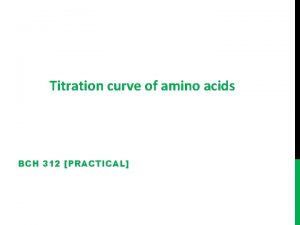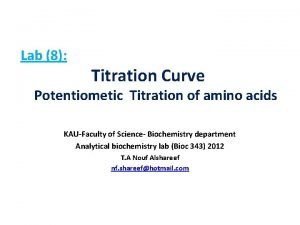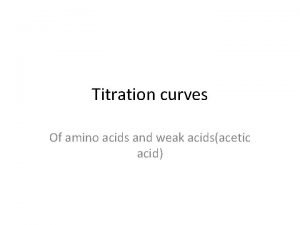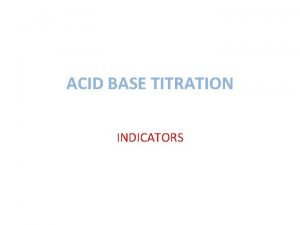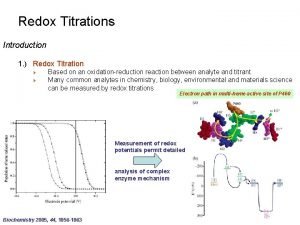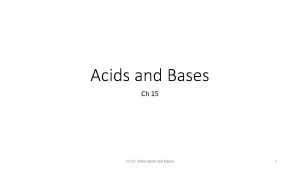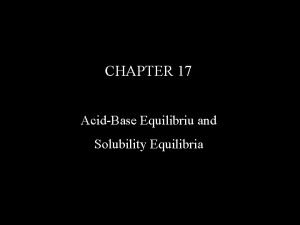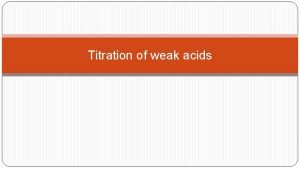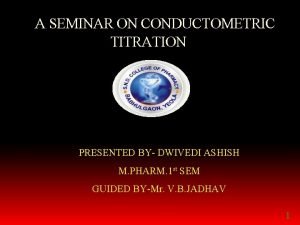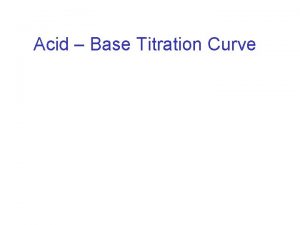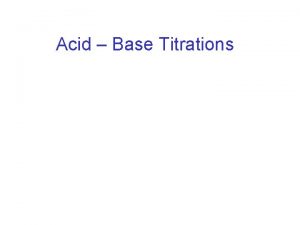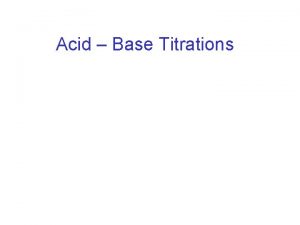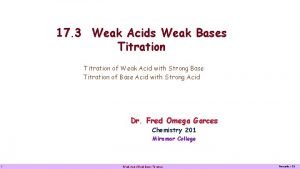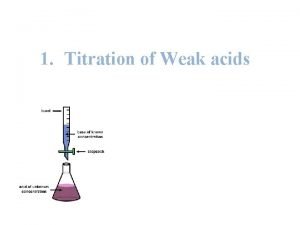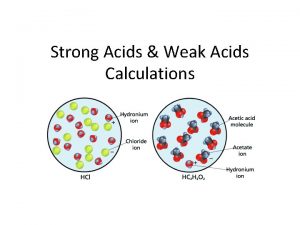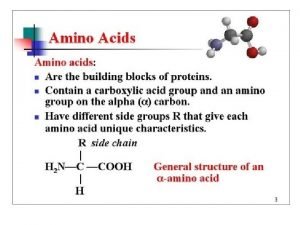Titration curve of weak acids Titration titration is














- Slides: 14

Titration curve of weak acids


Titration

• titration is a procedure for carrying out a chemical reaction between two solutions by the • controlled addition from a burette of one solution (the titrant) to the other, allowing measurements to be made throughout the reaction. • For a reaction between an acid and a base, • a titration is useful for measuring the p. H at various points throughout the reaction. • A titration curve is a graph of the p. H as a function of the amount of titrant (acid or base) added.


• The equivalence point of the titration is the point at which exactly enough titrant has been added to react with all of the substance being titrated with no titrant left over. • In other words, at the equivalence point, the number of moles of titrant added so far corresponds exactly to the number of moles of substance being titrated • In an acid-base titration, there is a 1: 1 acid: base stoichiometry, so the equivalence point is the point • where the moles of titrant added equals the moles of substance initially in the solution being titrated. )

• The equivalence point for a weak acid-strong base titration has a p. H > 7. 00. • the p. H will change rapidly at the very beginning and then have a gradual slope until near the equivalence point. • The gradual slope results from a buffer solution being produced by the addition of the strong acid or base, which resists rapid change in p. H until the added acid or base exceeds the buffer's capacity and • the rapid p. H change occurs near the equivalence point.


• The most common use of titrations is for measuring unknown concentrations. This is done by titrating a known volume of the unknown solution with a solution of known concentration and finding the volume of titrant needed to reach the equivalence. • The volume and concentration of titrant can be used to calculate the moles of titrant added. For acid-base titrations, the equivalence point can be found very easily. A p. H meter is simply placed in the solution being titrated and the p. H is measured after various volumes of titrant have been added to produce a titration curve. The equivalence point can then be read off the curve.

• Indicators can also be used to track the p. H in a titration, usually as a means of detecting the equivalence point of the titration. • The point in the titration at which the colour changes is known as the endpoint of the titration.

• The endpoint of a titration is NOT the same thing as the equivalence point. The equivalence point is a single point defined by the reaction stoichiometry as the point at which the base (or acid) added exactly neutralizes the acid (or base) being titrated.

• The endpoint is defined by the choice of indicator as the point at which the colour changes. Depending on how quickly the colour changes, the endpoint can occur almost instantaneously or be quite wide.


 Difference between a strong and weak acid
Difference between a strong and weak acid Titration curve of amino acids
Titration curve of amino acids Glycine titration curve
Glycine titration curve Titration curve of glycine
Titration curve of glycine Strong acid-strong base titration indicator
Strong acid-strong base titration indicator Titration curve strong base weak acid
Titration curve strong base weak acid Redox titration curve
Redox titration curve Strong vs weak acids
Strong vs weak acids Acids and bases
Acids and bases Difference between a strong and weak acid
Difference between a strong and weak acid Weak acid and weak base reaction
Weak acid and weak base reaction Strong base
Strong base Titration curve of lysine
Titration curve of lysine Advantages of conductometry
Advantages of conductometry Strong acid weak base titration
Strong acid weak base titration

